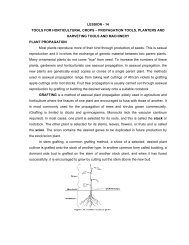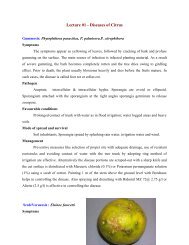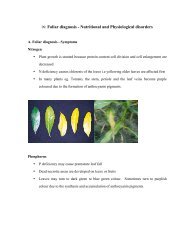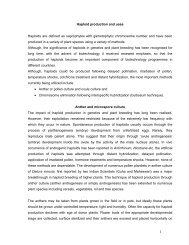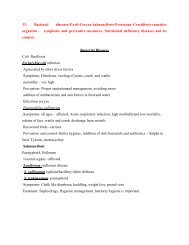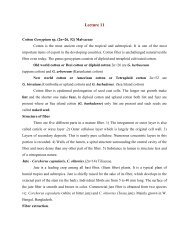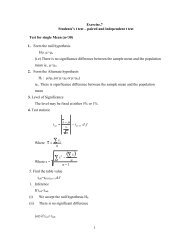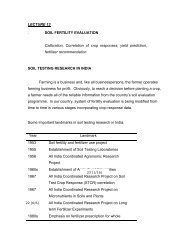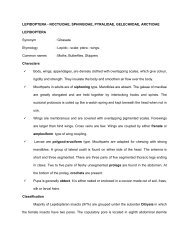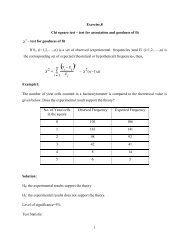Precision Farming Guidelines - TNAU
Precision Farming Guidelines - TNAU
Precision Farming Guidelines - TNAU
Create successful ePaper yourself
Turn your PDF publications into a flip-book with our unique Google optimized e-Paper software.
TAMILNADU PRECISION FARMING PROJECTOPERATIONAL GUIDELINESCluster approachThe cluster approach was adopted for operational conveniences and betterlogistics. The consolidation of holdings was not done in as much as the farmholding were too small and there was lesser compatibility among the farmers.The cluster approach rendered support to collective marketing through mutualconsultations and discussions. There were proactive farmers, active farmers andindifferent farmers in each cluster at the beginning of the project but theirawareness level at the end of harvest of 1 st crop was satisfactory to accept thechange in perception and mindset. There are ten registered <strong>Precision</strong> FarmersAssociations and they regularly meet during first week of every month to discussabout the markets and interact with buyers and input suppliers. Every one of theassociation is slowly getting empowered in as much as it acts as redressalmechanism for the problems of the farming.<strong>Precision</strong> Farmers Associations at Dharmapuri have established their own AgroService to deal with seeds, fertilizer, pesticides etc., They are able to procure anddeliver better inputs in required quantities at required time at reasonable prices(with a transparent margin) to the concerned association member farmers. Thefirm was incorporated under company’s Act and started functioning from01.02.07. It is a total empowerment of the farmers to become entrepreneurs.Key technologiesRemote sensing technologyMaking use of the GIS, the physiographic map, soil map and land use map forDharmapuri and Krishnagiri districts were developed. The remote sensingprogramme enabled the scientists to exactly locate the actual field to scale mapits boundary. Two sites were selected for the observations viz., field atPeriyammittahalli and a field at Thorapalli. The data on N, P, K, Ca, Mg, Mn, Fe
and Cu were collected and variability for the field and in field variability wereassessed. This enabled the scientists to precisely apply the required nutrient inaccurate quantities to the root zone during critical phases of crop growth.Chisel ploughThe chisel plough technology ensures better aeration to root zone and effectivedrainage during rainy days. Further it helps the plants to develop root systemwith characteristic uniformity, pattern, and architecture and in adequate mass.The Chisel plough needs to be operated once in two years. Compared to singletine chisel plough five tine chisel is effective in hard soils.Hi-Tech Community NurseryThe seedlings are to be raised in pro trays under net houses with insect proofnetting making use of (EC and pH adjusted) coco peat media treated withpseudomonas. The seedlings produced will be strikingly uniform with similarphysical and physiological age thus ensuring 100 per cent field stand and sustain100 per cent productive plants. The root mass is on the outer surface of root balland hence there is no causality. The Cabbage and Cauliflower seedlings areextremely sensitive to pH and EC of the media while chilli and brinjal Hybridseedlings are hardy. One net house nursery (300sm) is recommended for everycluster consisting of 20 ha.Drip and Fertigation SystemDrip and fertigation system ensures water economy, precise application of watersolublefertilizers to root zone and keep an ideal soil moisture regime of 60percent and aeration of 40 %. In conventional system, immediately afterirrigation, the air gradient of soil becomes zero and moisture gradient becomes100 per cent. Before irrigation the gradients are reversed thus exerting stressover the root zone. In fertigated fields, the moisture regime was 60 per cent andair gradient was 40 per cent. Thus the growth became unchecked from seedlingto harvest. Surface of the soil is dry during most part of the cropping season
hence less weeds which reduces labour expenses on weeding and lesspathogen which reduces cost of plant protection. Further the row crop geometryrenders effective spray of pesticides and residual toxicity is comparatively lessthan the conventional system. Fertigation ensures precise dosage at criticalstages of the crop in the immediately available form and hence the crop growth isunchecked throughout the crop period. Extended harvest is possible withfertigation.Growing crops and growing with the cropsThe field scientists stayed at villages and extended the technical support to thefarmers throughout the crop period. The growing with the crop has made all thedifference.Market supportThe marketing scientists have taken the beneficiary farmers to market places likeCochin, Koyampedu, Bangalore-Safal and Coimbatore and sensitized them onthe importance of minimal grading and sorting and timely delivery to the market(say 3.00 A.M). Further the buyers from the market were taken to the projectssite and impressed them on the healthy, hi-tech production system, highlightenedthe best of the quality parameters and strengthened the supply chain. Thefarmers were provided with plastic crates and trained sufficiently on grading andsorting to different markets. The marketing scientists also studied the marketsituations and flow of vegetables and guided the farmers to select crop andvariety for cultivation during particular season, thus making the market-ledproduction in real sense.Benefits of the project• 60 to 80 % higher yield in all the crops (The highest possible yield recordsunder Indian conditions)• 90% plus first grade marketable produce• Weight by volume is 25% higher
• 30% premium price in the market• 5-6 days more shelf life• Less labour dependence• 30-40 % Water economy• Extended harvest ensuring sales during the period of peak price• Empowerment of farmers technically, economically and socially• Establishment of Producer Company incorporated under Company ActSpecial featuresEmpowerment of farmers and farmers’ forumThe beneficiary farmers’ were organized under various commodity forums andten various associations were formed.01. Adhiyaman <strong>Precision</strong> Farmer’s Association, Dharmapuri02. Thiruvalluvar <strong>Precision</strong> Farmer’s Association, Dharmapuri03. Moulayanoor <strong>Precision</strong> Farmer’s Association, Dharmapuri04. Mahatma Gandhi <strong>Precision</strong> Farmers’ Association, Dharmapuri05. Annamalaiyar <strong>Precision</strong> Farmers’ Association, Dharmapuri06. Bagalur Berigai <strong>Precision</strong> Farmers’ Association, Krishnagiri07. Sarvodaya <strong>Precision</strong> Farmers Association, Saragapally, Krishnagiri08. Sri Sathya Sai <strong>Precision</strong> Farmers Association, Jakkeri Krishnagiri.09. V.N.R. <strong>Precision</strong> Farmers Association, Rayakottai, Krishnagiri10. Dharmapuri <strong>Precision</strong> Farmers Agro Services Ltd., Dharmapuri, (FirstProducer Company in TamilNadu)The organizations were registered under societies act and they were impartedskills to develop awareness on latest state of art technologies. The forum hashelped them to buy the inputs directly from the manufacturers cutting the costdown to minimum and strengthened their bargaining power while selling theirproduce.
Insurance coverThe crops and systems may be insured making use of the insurance scheme inoperation both at Department end and insurance company end. The tomatogrowers feared most the hails storm during summer and theft of coils in themotors of the drip system. The Farmers’ forum and the United India Assuranceofficials meeting were organized and eventually, the insurance cover wasextended to the crop with a low premium of 4 per cent.Reduction in pesticide usageThe farmers were now aware of the intricacies of pesticide quality, the dosage,the time of spray and method of preparation. The practice of going for 16 roundsof combination sprays have been avoided and judicious combination has beenput into practice. The drip and Fertigation technology always maintain a dry soilfor a depth of 3 cm and this helps to reduce the weed growth and sporemultiplication.Promotion of brand valueThe Adhiyaman <strong>Precision</strong> Farmers’ Association has developed a ‘logo’ andbrand of their own and in each crate, the logo was pasted. The logo is nowgaining popularity with the buyers offering higher rate for crated with such logo.Farmers’ corporateThe corporate have four virtues with which they are successful viz.1. They have the capability to honour any order of high volume (Quantity)2. They do the cultivation professionally there by the physical and nutritivequalities are ensured (Quality)3. The 1 st lot and last lot are strikingly uniform (Uniformity)4. They are able to deliver in time (Timely delivery)These virtues viz., quantity, quality, uniformity and timely delivery are inculcatedin the minds of the farmers and the Farmers’ forum is now gaining the corporate
qualities and thus becoming a Farmers’ Corporate, a new model to emulate incountries like India where holdings are too fragmented and empowerment ofFarmers’ Forum is the only way.Farm documentation and record maintenanceEach farmer has to maintain a weekly DMS to record all the activities of theweek, including inputs used and the harvests made. (Annexure-VI a, b and c).This record also helps to work out the economics of production and arrive at costbenefit ratio. The farm records will be printed and supplied to the PIAs by TamilNadu Agricultural University based on their indent. The PIAs should send themoney to <strong>TNAU</strong> towards the supply of farm records. The newer laws in EUdemand traceability which is essentially through maintenance of records at farmlevel. The records are to be signed both by scientists / ADA or ADH and thefarmers and are a fool proof document to ensure food safety in long run.Selection processCriteria for selection of beneficiary farmersa. Individual farmer owning minimum of one ha of land is eligible (For widespaced crops like coconut and perennial horticultural crops, the unit size shallbe more than 1 ha, adequate to avail Rs.40,000/- subsidy, i.e. the totalestimate may be maximum of Rs.80,000/-)b. Two or three farmers having less than 1 ha also can join together (by mutualagreement duely registered) and avail one ha with common water facility.c. If the deed and title of the land is in the name of parents and if heirs whocultivate the land prefers to become the beneficiary, the legal land ownershould tender a letter of authorization in favour of the heir who cultivates theland.d. Twenty farmers constitute one cluster.e. The selection of 20 farmers as cluster may be from one revenue village to theextent possible. If not from two neighboring villages but not in a scatteredmanner.
f. The farmers who have availed drip under Micro Irrigation Scheme (MIS) and<strong>Precision</strong> <strong>Farming</strong> for an area less than 5 ha are also eligible.g. Farmers interest group having minimum 20 members owning 1 ha eachcommodity based associations having minimum of 20 members owning oneha each. The land / field need not be contiguous but with in a block ispreferable.Criteria for selection of fieldsa. Soil is of moderate fertility and not a problem soil with extreme alkalinity oracidity or sodicity.b. Should have own water source or if the source is to be shared by theconcurrence of other owners in writing to run the motor for two hours daily,needs to be produced.c. The land title should be in the owners name (Chitta, Adangal and RSR to beproduced)d. Pumping system to ensure minimum of 1.5 kg / cm pressure and 12,500 litredischarge of water / hour.e. The pH of the soil should be relatively 6-8 and EC of irrigation water may beless than 1.5 mmhos/cmSelection procedurea. Wide publicity about the programme through press meet, presentation atgrievance day meet of the district and through the banners and hoardings.b. Call for applications from eligible farmers and farmers association (Form A:Annexure-I)c. Preliminary scrutiny of application by implementing departments to verify legalownership.d. Land under tenancy should have a registered document as evident.
Selection CommitteeDistrict levelThe selection committee for each district shall consist of the following members:Joint Director of Agriculture: ChairmanScientist nominated by the university : MemberExecutive Engineer (Agrl.Engineering) : MemberDeputy Director (Agrl.Marketing): MemberDeputy Director of Horticulture: ConvenorThe committee shall examine the legal ownership of the farm land and or hisauthourised cultivator. Before the selection, the committee shall ensure properpumping system as given under 4.2. The copy of the selected beneficiaryfarmers list shall be sent to the DEE for monitoring and evaluation purpose by theJDA as and when the lists are finalized and approved by the committee.Bilateral agreementThere should be a bilateral agreement between the beneficiary farmer and thePIA represented by the Heads of Stations and block level Assistant DirectorAgriculture, Assistant Director of Horticulture which indicates the role andresponsibilities of both of them. (Annexure II)How to applyThe farmer may make one application in the prescribed format and send to anyone of the PIA of his choice.Purchase procedureInstallation of drip system<strong>TNAU</strong>: The firms approved under TANHODA shall be adopted for installation ofdrip system. The choice of the firm (from among the firms approved underTANHODA) is exclusively by the farmers.
Departments: The firms approved under TANHODA shall be adopted forinstallation of drip system. The choice of the firm (from among the firmsapproved under TANHODA) is exclusively by the farmers.Awareness meetings may be organized by the PIAs for the benefit of the farmerson drip system and the firms at each cluster. The farmer shall install the dripsystem at his own initiative and pay to the firm directly deducting Rs. 40,000 (Rsforty thousand only towards subsidy) from the invoiced sum with in the stipulatedperiod by the PIA. The drip system should have all the componentsrecommended by the Tamil Nadu Agricultural University as given in theAnnexure III.Purchase of inputsInputs like water soluble fertilizer, plant protection chemicals seeds and plantsshall be purchased as per the approved rates of TANHOPE. TANHOPE shallfinalize the rates for the newer items, if any, among the category of inputsindicated above.If for any of the above category, TANHOPE rates are not available, KVK shallpurchase as per norms of Tamil Nadu Agricultural University and departmentsshall purchase following the department norms.Establishment of Net house nurseryNet house nursery of 300 m 2 shall be established by the PIA as a commonfacility for each cluster at a cost of Rs. 1.00 lakh as per the design developed byTamil Nadu Agricultural University (Annexure-IV) and handed over to the legallyregistered beneficiary farmers Association of such cluster. The structure erectionwill be as per the design enclosed in the Annexure. Every 20 farmers can registeran association and become eligible for one such net house. The association shallhire 10 cents of land for this purpose and the future profit goes to the association.
The net house nursery structure will be established by the Estate Officer, TamilNadu Agricultural University, Coimbatore for <strong>TNAU</strong>; State departments mayfollow their norms to establish the net house nursery.CropsAgriculture: Sugarcane, cotton, sunflower, maize, pulses, oilseeds, coconut (Forcoconut preferably 10 year old gardens may be selected) and mulberry or for anyspecial crop suited to the block.Horticulture: Annuals like vegetables, flowers, spices, medicinal plants and oneyear long season crops like banana, tapioca and turmeric and any special cropsuited to the block.Fertigation schedule for the cropsThe detailed fertigation schedule is given in the Annuxure V and trainings shallbe organized to extension workers to have better understanding of the scheduleand step by step procedure to compute for different sections of drip system withdifferent population density.AdministrationFarm records and record of input supplyThe farm record needs to be filled up every week and to be signed by eitherofficers of the department (ADA/ADH or his nominee among the AOs or HOs) orSMS, KVK and not by the field consultants.Release of inputs to beneficiary farmersi. At the start of the planting by few farmers, the input stock viz., Water SolubleFertilizer, Soil Health Card, Seeds and Plant Protection chemicals must be madereadily available at each centre.ii. To ensure synergy between the farm activity and supply of inputs in time (asand when farmers are ready for planting), it is advised to buy minimum quantity
of water soluble fertilizer and plant protection chemicals immediately and keepthem as nucleus stock so as to supply the inputs in time to the farmerssynchronizing with farm operations. Plant protection chemicals also may beordered as below. Systemic and contact chemicals from the approved list of theTANHOPE as uniform kit (worth Rs.5000) to all the farmersIn case, if the farmer’s choice is crops like tapioca, banana suckers, whichfarmers themselves mobilize, the budget towards seeds / plants componentsmay be used to supply additional quantity of water soluble fertilizer in lieu ofseeds and plants.In case, if the pests and diseases require new chemicals to be purchased, thefarmers may be allowed to buy on his own and the budget towards plantprotection chemicals may be used for supplying additional quantity of watersoluble fertilizer in lieu of seeds and plants.The total cost of inputs to individual farmer should not exceed Rs.25,000/-Drip and fertigation systema. The farmer may indicate his preference of Micro Irrigation (MI) Company inhis application (Annexure-VII)b. The MI Company so preferred shall prepare the estimate and submit it to theProfessor and Head, KVK/ADA/ADH.c. After scrutinization, Professor and Head KVK/ADA/ADH shall give the workorder to the company with a copy marked to the farmer concernedd. The company shall execute the work after collecting the balance money fromthe farmers over and above the subsidy portion.e. <strong>TNAU</strong>: On completion of installation of drip system, the firm shall prepare theinvoice (triplicate) which shall be verified at site for the correctness of thephysical quantity by the ADH/ADA or Head KVK. Both farmer and ADH/ADA/Head KVK shall sign on the back of the invoice and forward to JDA forrelease of subsidy. The Head, KVK shall retain the 2 nd copy of the invoice torelease the subsidy from university and forward the same to DEE.
Department: ADA/ADH shall submit all these copies of the invoice to JDA forrelease of subsidy. The Director of Extension Education shall authorizetrained staff of Tamil Nadu Agricultural University to check verify the systemand JDA shall do the same by authorizing a trained staff of department tocheck verify the system and release the subsidy on satisfactory installation ofthe system.f. The invoice / bill for drip and fertigation system should be from the approvedfirms only and not from the dealers.Recruitment of field consultants<strong>TNAU</strong> shall place field consultants on contractual service as per <strong>TNAU</strong> normsand Joint Director / DDH may appoint field consultants by following departmentnorms.Such field Consultants shall be assigned with the responsibilities like assistingthe farmers in carrying out all the field operations. They are not authorized tosign any document related to supply of inputs.Bench Mark Survey & MeasurablesThe following are the measurables01. 80-100% yield increase over the benchmark level02. 30-35% water economy03. 70-80% marketable high quality produce04. 30-40% reduction in pesticide use05. 60-70% increase in market awareness among the farmersTraining the farmer at Project site12,800 beneficiary farmers and all the extension functionaries are to be providedwith hands on training on precision farming at Dharmapuri and Krishnagiri projectsite before July 2008. Hence the resource farmers of the all cluster levelregistered associations and Dharmapuri <strong>Precision</strong> <strong>Farming</strong> Agro Services Ltd
shall be involved in the training programme. Further the farmer to farmer mode oftraining has immediate impact. The following are the associations and limitedcompany who shall be involved in the training.Training shall be organized at Regional Research Station (RRS), Paiyur for thefarmers from different districts as well as for the development functionaries jointlyby the <strong>TNAU</strong> & Cluster level Associations and Agro Services Ltd., as givenbelow.01. Adhiyaman <strong>Precision</strong> Farmer’s Association, Dharmapuri02. Thiruvalluvar <strong>Precision</strong> Farmer’s Association, Dharmapuri03. Moulayanoor <strong>Precision</strong> Farmer’s Association, Dharmapuri04. Mahatma Gandhi <strong>Precision</strong> Farmers’ Association, Dharmapuri05. Annamalaiyar <strong>Precision</strong> Farmers’ Association, Dharmapuri06. Bagalur Berigai <strong>Precision</strong> Farmers’ Association, Krishnagiri07. Sarvodaya <strong>Precision</strong> Farmers Association, Saragapally, Krishnagiri08. Sri Sathya Sai <strong>Precision</strong> Farmers Association, Jakkeri Krishnagiri09. V.N.R. <strong>Precision</strong> Farmers Association, Rayakottai, Krishnagiri10. Dharmapuri <strong>Precision</strong> Farmers Agro Services Ltd., Dharmapuri (FirstProducer Company in Tamil Nadu)Exposure visitThe exposure visit to markets shall be conducted by the staff of Directorate ofAgri-Business and Marketing.Generala. Application of organic manures before planting must be compulsory for allcrops. The quantum may vary from crop to crop.b. The seedlings requirement may be planned well in advance and priorarrangements may be made with nurseries available at Dharmapuri if noshade net house is available for the first crop in all the districts.
c. Fix time limit to selected farmers for installation of drip in writing andbeyond the time limit remove the farmer name from the list and include onefrom the wait listed farmers.d. The farmers may be advised not to use straight fertilizers though thefertigation system.e. Any contingency measures during implementation could be met from theoverall savings as recommended by the District Level Committee.Monitoring and EvaluationMonitoring and evaluation of the programme implemented by three differentagencies shall be monitored and evaluated by <strong>TNAU</strong> by the followingmechanism:a. All Heads of KVK and ADH or ADA shall submit the monthly progressreport (Annexure VIII a & b) to DEE and DDH/JDA respectively forconsolidation and the DDH/JDA shall submit the consolidated report to therespective PIAs with a copy to Director of Extension Education, <strong>TNAU</strong>,Coimbatore for monitoring and evaluation.b. DEE or the technical Directors / hired Project Scientists authorized by theUniversity shall undertake periodical inspection of field and field records inall the districts under all three PIAs of the programme regularly at monthlyperiodicity.c. Workshops shall be held at <strong>TNAU</strong> to discuss about the process ofimplementation of the programme once in two months.d. DEE shall conduct periodical meetings at the JDAs / DDHs office to reviewthe progress of the programme.Technical Cell at DEE office: A technical cell shall be created at DEE`s office.Any technical issues either from the farmers or from the Extension Staff may bereferred to the cell in writing either by fax (0422 6611433) or by e mail(nadppf@tnau.ac.in) for immediate clarifications.



